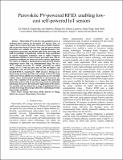| dc.contributor.author | Kantareddy, Sai Nithin R. | |
| dc.contributor.author | Mathews, Ian | |
| dc.contributor.author | Sun, Shijing | |
| dc.contributor.author | Layurova, Mariya | |
| dc.contributor.author | Thapa, Janak | |
| dc.contributor.author | Correa-Baena, Juan-Pablo | |
| dc.contributor.author | Bhattacharyya, Rahul | |
| dc.contributor.author | Buonassisi, Anthony | |
| dc.contributor.author | Sarma, Sanjay E | |
| dc.contributor.author | Peters, Ian Marius | |
| dc.date.accessioned | 2020-08-17T18:27:30Z | |
| dc.date.available | 2020-08-17T18:27:30Z | |
| dc.date.issued | 2019-09 | |
| dc.identifier.issn | 1530-437X | |
| dc.identifier.issn | 1558-1748 | |
| dc.identifier.issn | 2379-9153 | |
| dc.identifier.uri | https://hdl.handle.net/1721.1/126629 | |
| dc.description.abstract | Photovoltaic (PV) cells have the potential to serve as on-board power sources for low-power IoT devices. Here, we explore the use of perovskite solar cells to power Radio Frequency (RF) backscatter-based IoT devices with few \mu \text{W} power demand. Perovskites are suitable for low-cost, high-performance, low-temperature processing, and flexible light energy harvesting that hold the possibility to significantly extend the range and lifetime of current backscatter techniques such as Radio Frequency Identification (RFID). For these reasons, perovskite solar cells are prominent candidates for future low-power wireless applications. We report on realizing a functional perovskite-powered wireless temperature sensor with 4 m communication range. We use a 10.1% efficient perovskite PV module generating an output voltage of 4.3 V with an active area of 1.06 cm2 under 1 sun illumination, with AM 1.5G spectrum, to power a commercial off-the-shelf RFID IC, requiring 10 - 45 \mu \text{W} of power. Having an on-board energy harvester provides extra-energy to boost the range of the sensor (5 \times ) in addition to providing energy to carry out high-volume sensor measurements (hundreds of measurements per min). Our evaluation of the prototype suggests that perovskite photovoltaic cells are able to meet the energy needs to enable fully power-autonomous low-power RF backscatter applications of the future. We conclude with an outlook into a range of applications that we envision to leverage the synergies offered by combining perovskite photovoltaics and RFID. | en_US |
| dc.language.iso | en | |
| dc.publisher | Institute of Electrical and Electronics Engineers (IEEE) | en_US |
| dc.relation.isversionof | http://dx.doi.org/10.1109/jsen.2019.2939293 | en_US |
| dc.rights | Creative Commons Attribution-Noncommercial-Share Alike | en_US |
| dc.rights.uri | http://creativecommons.org/licenses/by-nc-sa/4.0/ | en_US |
| dc.source | arXiv | en_US |
| dc.title | Perovskite PV-Powered RFID: Enabling Low-Cost Self-Powered IoT Sensors | en_US |
| dc.type | Article | en_US |
| dc.identifier.citation | Kantareddy, Sai Nithin R. et al. "Perovskite PV-Powered RFID: Enabling Low-Cost Self-Powered IoT Sensors." IEEE Sensors Journal 20, 1 (January 2020): 471 - 478 © 2020 IEEE | en_US |
| dc.contributor.department | Massachusetts Institute of Technology. Photovoltaic Research Laboratory | en_US |
| dc.contributor.department | Massachusetts Institute of Technology. Auto-ID Laboratory | en_US |
| dc.contributor.department | Massachusetts Institute of Technology. Department of Mechanical Engineering | en_US |
| dc.relation.journal | IEEE Sensors Journal | en_US |
| dc.eprint.version | Author's final manuscript | en_US |
| dc.type.uri | http://purl.org/eprint/type/JournalArticle | en_US |
| eprint.status | http://purl.org/eprint/status/PeerReviewed | en_US |
| dc.date.updated | 2020-08-04T19:11:56Z | |
| dspace.date.submission | 2020-08-04T19:11:58Z | |
| mit.journal.volume | 20 | en_US |
| mit.journal.issue | 1 | en_US |
| mit.license | OPEN_ACCESS_POLICY | |
| mit.metadata.status | Complete | |
